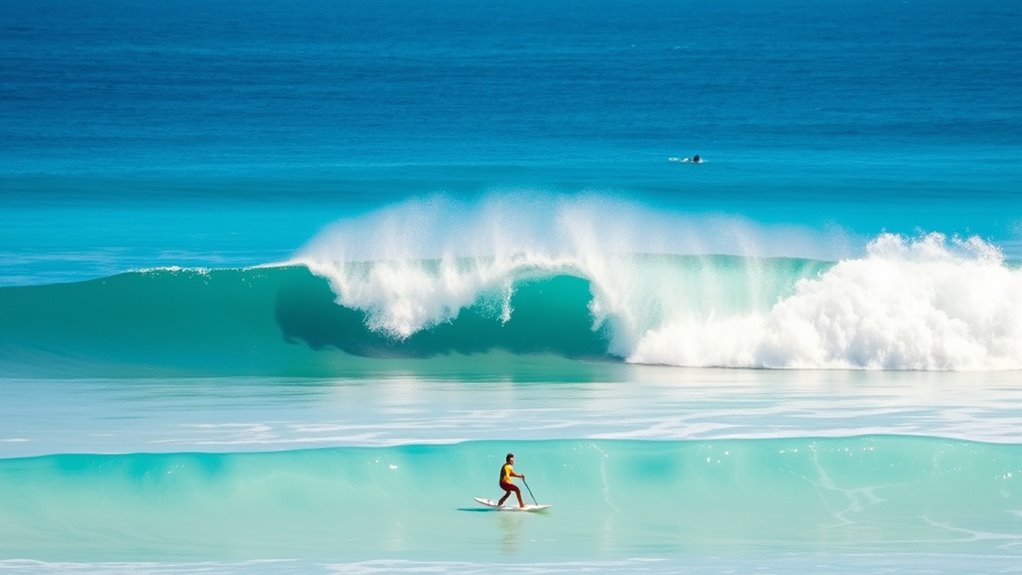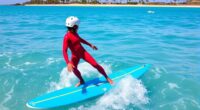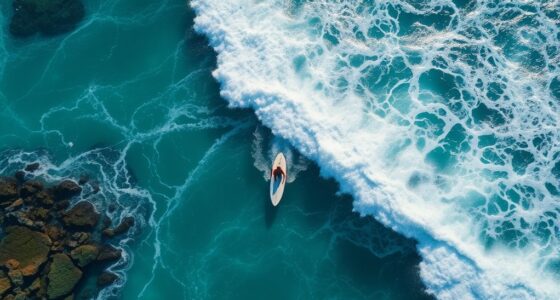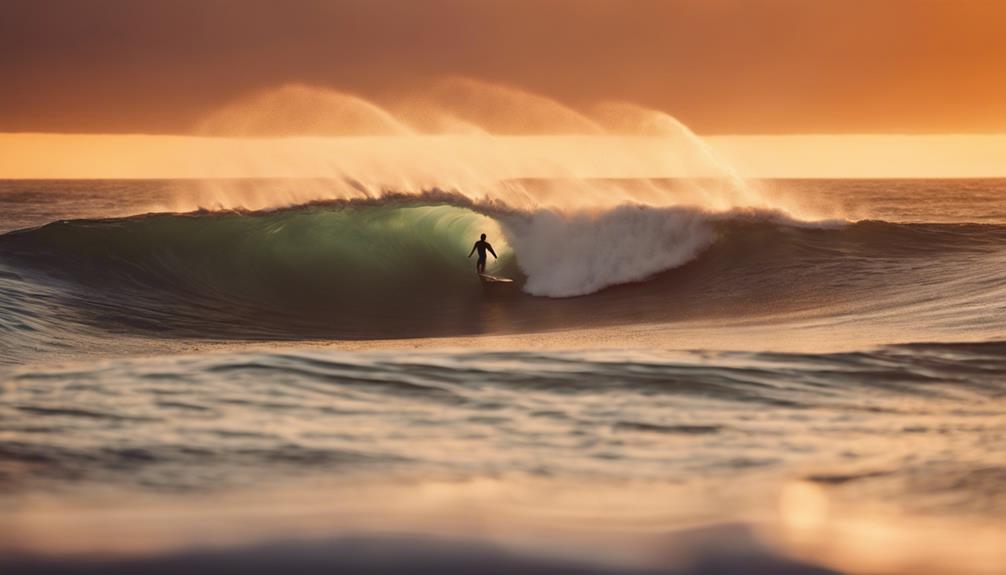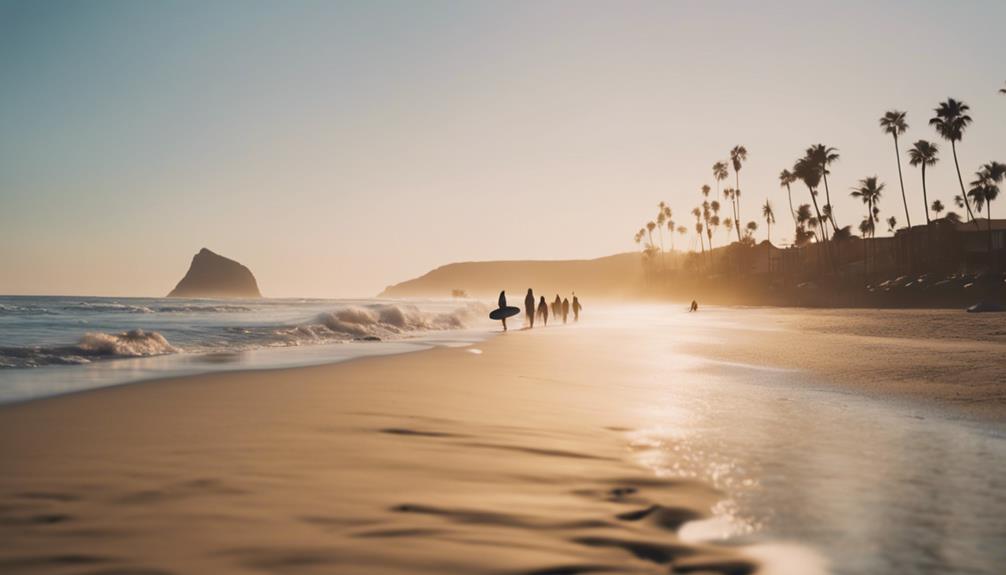Understanding different types of surfing waves helps you choose the best conditions for your skill level and goals. You’ll learn how swell size, wave formation, and underwater terrain shape the waves you surf. Beach breaks, reef breaks, and point breaks each offer unique challenges and experiences. Recognizing these differences lets you anticipate how waves will break and ride. Keep exploring, and you’ll discover how environmental factors influence your surf sessions.
Key Takeaways
- Swell size and wave period determine wave energy, size, and quality, influencing the surf challenge and rideability.
- Beach breaks form over sandy seabeds with variable shapes, often suitable for beginners, while reef breaks occur over coral or rock, favoring advanced surfers.
- Point breaks are characterized by long, peeling waves generated when swells hit headlands, ideal for extended rides.
- Special or rare waves result from unique environmental factors like seismic activity, currents, or sediment shifts, creating unpredictable surf conditions.
- Understanding local topography, tide, and weather patterns is essential for predicting wave types and ensuring safe, optimal surfing experiences.
Types of Swell and Wave Formation
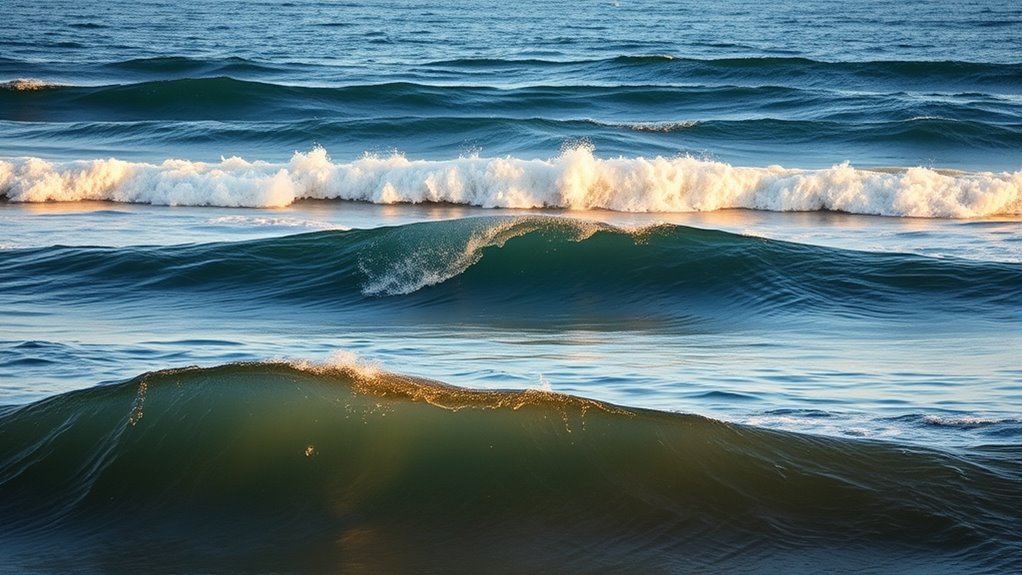
Understanding the different types of swell is key to predicting and riding waves effectively. Swell size, which refers to the height of the waves, directly influences how challenging a surf spot will be. Larger swells produce bigger, more powerful waves, while smaller swells create gentler surf. Wave period, the time between successive waves, also plays a vital role; longer wave periods generally indicate more energy and better quality waves. When you observe a swell with a long period, expect waves to be cleaner and more rideable. The combination of swell size and wave period helps surfers determine the best conditions for their skill level and the type of wave they want to ride. Recognizing these factors enhances your ability to anticipate how waves will break and how to position yourself accordingly.
Beach Break Waves
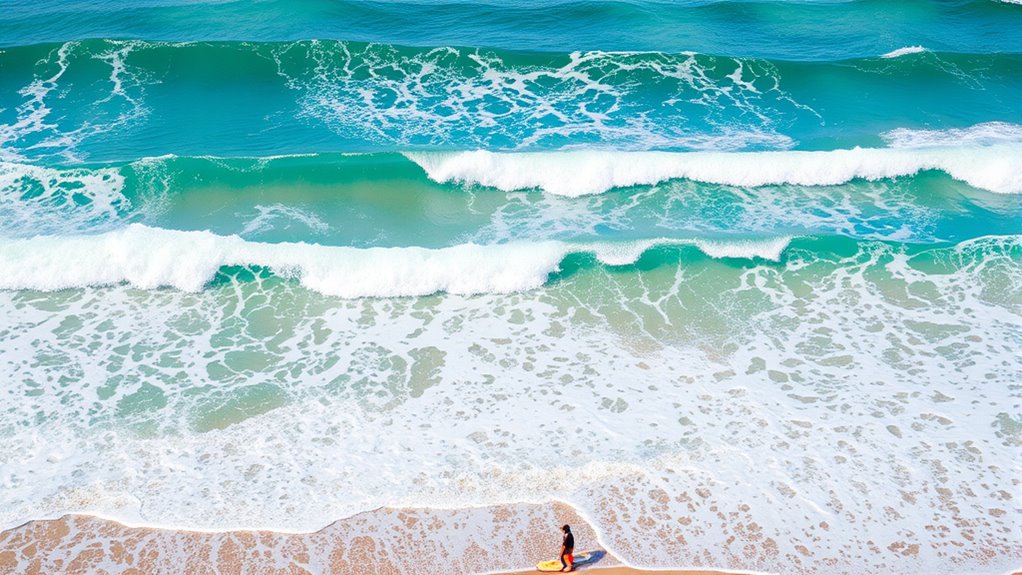
Beach break waves occur when swell energy hits a sandy seabed, causing the waves to break directly over the shallow bottom. The tide influence plays a key role, as high tide often softens the break, while low tide sharpens and shortens the wave face. Sandbar formation is essential for beach breaks, as shifting sands create natural peaks and peaks that generate surfable waves. These waves tend to be more forgiving for beginners due to their less reef-like structure and gentler breaks. You’ll notice that beach break waves are highly variable, depending on tide, swell direction, and sandbar shape. This makes each surf session unique, with opportunities for both mellow rides and more challenging waves, all influenced by the dynamic sandy environment beneath you. Additionally, the presence of projector technology in surf forecasting tools can help predict optimal conditions for beach break surfing, and understanding wave formation processes can further enhance anticipation of surf conditions. Recognizing the environmental factors that affect sandbar stability can also improve your ability to choose the best surf spots and times. Changes in sand movement contribute to the constantly changing nature of beach break waves, emphasizing the importance of staying updated on local conditions.
Reef Break Waves
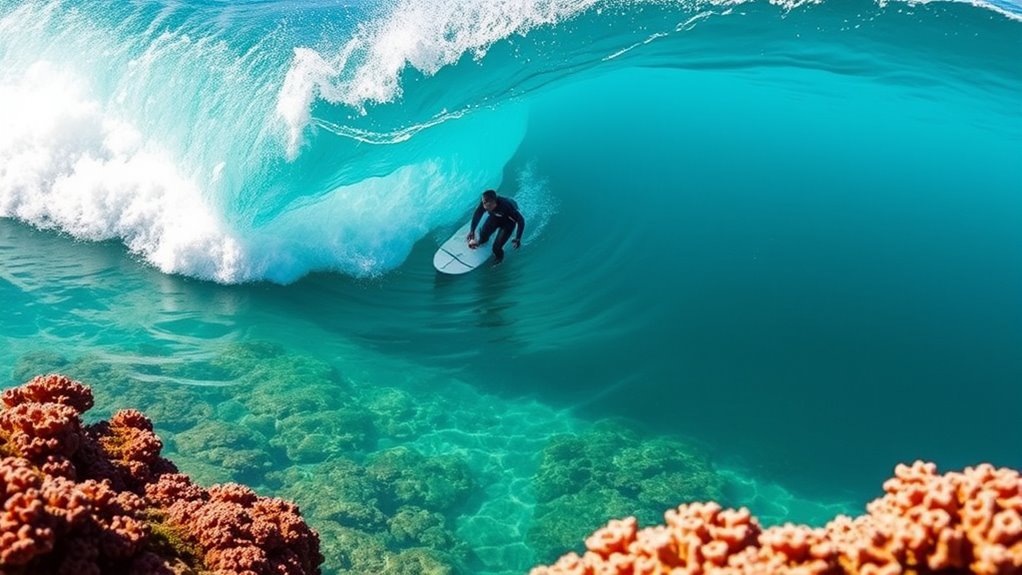
Reef break waves form when swell energy interacts with a coral or rock reef, creating powerful and often sharply breaking surf. These waves typically rise suddenly as they reach the shallow coral formations, producing clean, well-defined barrels that attract advanced surfers. Because reefs are often made of sharp rocks and coral, reef hazards are a significant concern. You need to be cautious of jagged edges and unpredictable reef structures that can cause injuries. The best reef break waves occur over healthy, stable coral formations, but always remember that the underwater environment can change, making conditions hazardous. Proper knowledge of the reef, local advice, and respect for the environment will help you enjoy reef break waves safely. Additionally, understanding wave formation principles can improve your ability to predict and surf these challenging waves effectively. Being aware of reef stability is also crucial to avoid unexpected collapses or shifts that could pose risks while surfing.
Point Break Waves
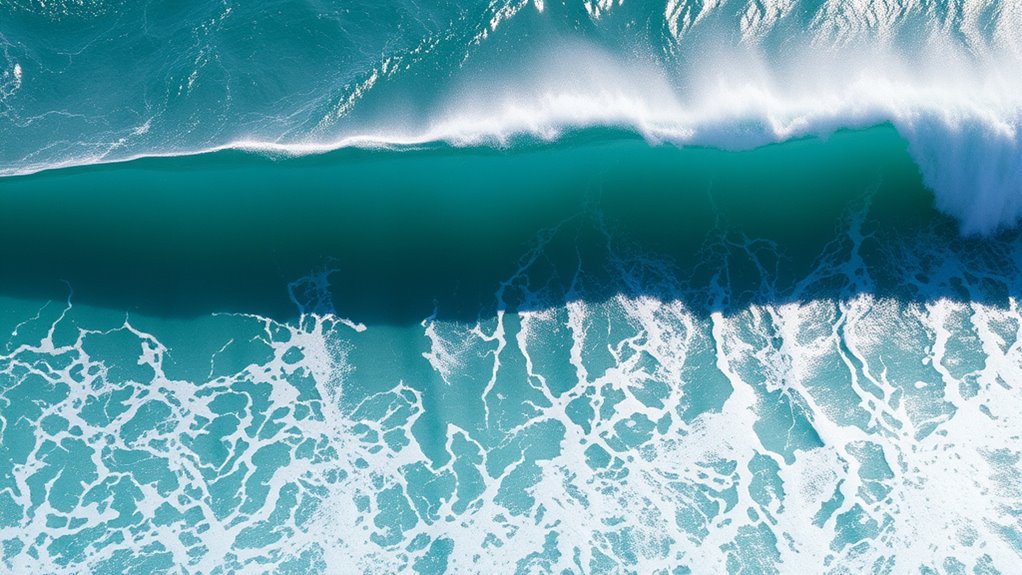
Point break waves form when ocean swells hit a rocky or coral headland, redirecting the energy to create long, peeling waves. You’ll find these waves best under steady offshore winds and clean conditions, which allow for smooth rides. Some of the most famous point breaks include Malibu, Jeffreys Bay, and Rincon, offering surfers consistent and quality surf. Additionally, well-preserved cultural narratives are often showcased through surf films that highlight the unique characteristics of these waves. In some regions, local adaptations and traditional customs influence how surfing is practiced and celebrated around these iconic breaks. The effectiveness of these waves is supported by advanced filtration technology, which enhances the overall surfing experience. Proper understanding of wave formation can further improve surfers’ ability to choose the best conditions for riding these remarkable waves. Moreover, understanding the remote hackathons and virtual collaboration tools can inspire innovative approaches to capturing and sharing the essence of these surfing spots.
Wave Formation Process
When a swell approaches a point break, the underwater topography plays a crucial role in shaping the wave. As the swell moves closer, wave energy concentrates along the rocky coastline, causing the wave to accelerate and grow taller. The unique shape of the point creates a natural funnel, focusing the wave’s energy and producing a longer, more rideable face. Tidal influence also affects the wave formation, with high tide often softening the break and low tide sharpening it. As the water level shifts, the wave’s speed and shape change, which impacts how it forms and breaks. Understanding wave formation dynamics can help surfers anticipate the best times to ride these waves. Additionally, wave behavior can vary depending on local conditions, making each surf session unique and requiring surfers to adapt quickly. Recognizing tidal effects is essential for optimizing the timing and quality of your surf sessions. Moreover, awareness of local topography can assist surfers in predicting how the wave will break and improve their overall experience. Being mindful of current patterns can further enhance a surfer’s ability to choose the optimal moment for catching waves.
Ideal Surfing Conditions
The best conditions for surfing point break waves occur when the right combination of wind, tide, and swell align. Ideally, you want a moderate wave height—around three to six feet—so the waves are powerful enough to provide a long ride without being overwhelming. Wind direction plays a pivotal role; offshore winds blowing from land to sea help clean up the face of the wave, creating smooth, rideable surfaces. Onshore winds tend to break the wave’s face, making it choppy and less predictable. The tide should be at a level that exposes the point, often around mid-tide, offering the best shape and length for your ride. When these conditions come together, you can enjoy consistent, high-quality point break waves. Additionally, understanding how family dynamics influence personal experiences can help surfers appreciate the importance of harmony both in and out of the water. A clear understanding of wave mechanics can further enhance your ability to read and anticipate wave behavior, leading to better rides and safety. Recognizing how environmental factors impact wave formation can also improve your overall surfing performance, especially when considering how local geography influences wave shape and size. Properly assessing weather patterns can provide further insight into optimal surf conditions, making your surfing experience more enjoyable and safe.
Popular Point Breaks
Some of the most renowned surf spots worldwide are famous for their iconic point breaks, attracting surfers seeking long, peeling waves. These spots harness consistent wave energy, allowing for extended rides that test your skill and patience. As you navigate these breaks, it’s essential to respect surf etiquette—waiting your turn, avoiding crowded peaks, and communicating with fellow surfers. Point breaks often produce mellow, predictable waves ideal for intermediate and advanced surfers. Their long rides reward good positioning and timing, making them popular destinations. Keep in mind, the wave energy here can be powerful, so staying alert and respecting local rules ensure a safe and enjoyable experience for everyone. Mastering these breaks elevates your surfing and deepens your understanding of different wave types. Additionally, understanding the celebrity lifestyle insights associated with various surf locations can enhance your overall experience. Recognizing the sustainable practices employed at top surf spots can also contribute to preserving these environments for future generations.
River Mouth and Estuarine Waves

River mouths and estuaries often produce unique waves that differ markedly from open-ocean surf. These waves are shaped by river mouth dynamics, which influence how water flows and interacts with incoming swell. As sediment builds up or channels shift, estuarine wave patterns change, creating different types of surf. You’ll notice that these waves tend to be shorter, more powerful, and sometimes more unpredictable than open-ocean breaks. The fresh and saltwater mix also affects the wave quality, making them distinct. Because of the variable sediment and current conditions, surf here can be highly localized. Understanding these factors helps you anticipate how the waves will behave, ensuring you stay safe and make the most of the unique riding experience these estuarine environments offer.
Special Wave Conditions and Rare Types
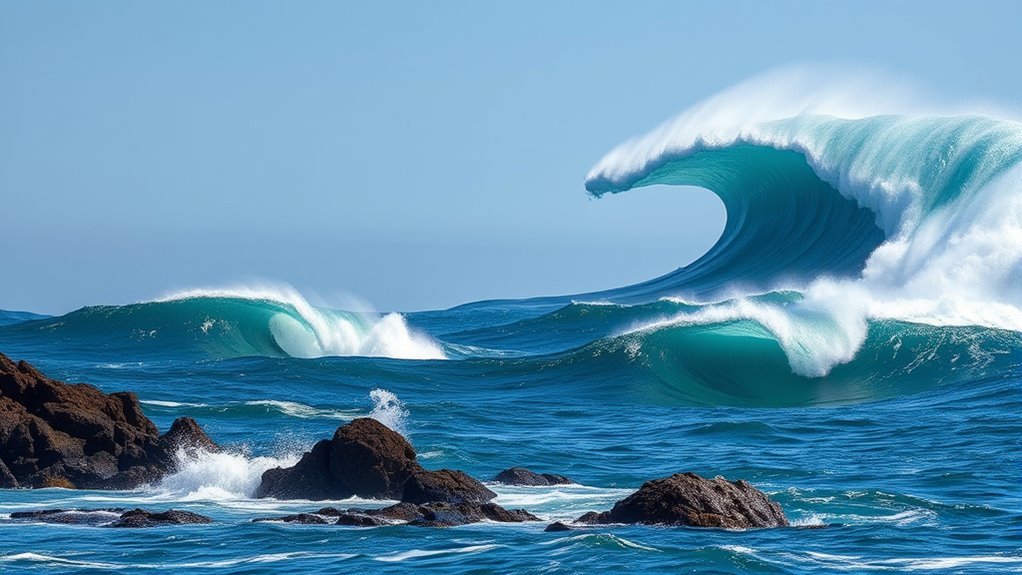
Rare wave types and unusual conditions can transform a typical surf session into a memorable experience. When you encounter rare wave phenomena, you might ride waves that form under unique circumstances, such as seismic activity or specific underwater topography. Unusual surf conditions, like strong currents, unusual wind patterns, or seasonal changes, also create extraordinary waves. These rare types often occur unexpectedly, demanding quick adaptation and a keen eye for environmental cues. For example, a sudden storm or a rare swell can produce waves that break differently from the norm, offering new challenges and thrills. By understanding these special wave conditions, you can seize opportunities to surf some of the most extraordinary, fleeting waves nature has to offer.
Frequently Asked Questions
How Do Wave Sizes Vary With Different Weather Patterns?
You’ll notice that wave height varies a lot with different weather patterns. When storm systems develop, they generate strong winds that transfer energy to the ocean, creating larger waves. These storms can produce massive, powerful surf suitable for advanced surfers. Conversely, calm weather results in smaller, gentler waves. So, your surfing conditions depend heavily on how storm systems influence wave size and wave height over time.
What Equipment Is Best for Riding Different Wave Types?
Did you know that choosing the right surfboard shape can improve your ride by up to 50%? For small, mushy waves, a wave paddle and a wider, more stable surfboard help you catch and ride easier. In bigger, powerful waves, a narrower, more streamlined surfboard with a good wave paddle offers better control. Select your equipment based on wave type to maximize fun and performance.
How Can Beginners Identify Safe Waves to Surf?
To identify safe waves, you should check the wave height—smaller, gentle waves are ideal for beginners. Look for areas with minimal rip currents, which can be dangerous if you’re not experienced. Observe the surf for consistency and avoid crowded spots to reduce collision risks. Always surf in designated beginner zones, and if unsure, ask local surfers or lifeguards for advice. Safety first guarantees you enjoy your surfing experience!
What Environmental Factors Influence Wave Quality Over Time?
Environmental factors like tidal fluctuations and wind conditions greatly influence wave quality over time. You’ll notice that during high or low tides, waves can become more or less powerful, affecting your surf experience. Wind conditions also matter—strong onshore winds tend to create choppy, less rideable waves, while offshore winds produce cleaner, better-shaped waves. Pay attention to these factors to choose the best times for surfing and improve your skills.
Are Certain Wave Types More Suitable for Advanced Surfers?
Did you know that over 60% of advanced surfers prefer reef waves for their challenging steepness? Yes, certain wave types, like reef waves with greater steepness, are more suitable for experienced surfers, offering powerful, hollow rides. In contrast, beach waves tend to be gentler. Your choice depends on your skill level and desire for challenge, but reef waves definitely push your limits and improve your surfing skills.
Conclusion
Now that you know the wild variety of surfing waves, you’ll feel like a wave wizard ready to conquer any swell that crashes your way. Whether it’s the mighty reef breaks or the secret river mouth waves, you’re armed with the knowledge to chase perfection and ride like a legend. So go out there, paddle fiercely, and turn every surf session into an epic adventure that’ll make your friends think you’ve got the ocean’s magic in your fingertips!

